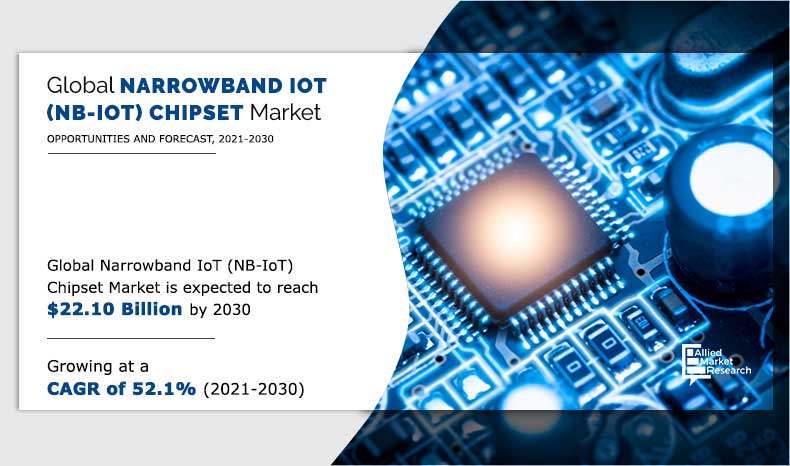Narrowband IoT (NB-IoT) chipset boasts power efficiency, which is a key aspect in low-power IoT networks. It assists in meeting the requirements of extended coverage of a particular area, especially in rural and deep indoors. The chipset allows device manufacturers to develop low-power, cost-sensitive connected devices at a global scale to monitor, manage, and control critical infrastructure, medical devices, logistic trackers, and a large variety of LPWA applications.
According to a new report published by Allied Market Research, titled, “Narrowband IoT (NB-IoT) chipset Market by Component, Deployment, Application, and Industry Vertical: Global Opportunity Analysis and Industry Forecast, 2021–2030,” the narrowband IoT (NB-IoT) chipset market size was valued at $425.0 million in 2020, and is projected to reach at $22,105.6 million by 2030, growing at a CAGR of 52.1% during the forecast period.
The key driving forces of the global narrowband IoT (NB-IoT) chipset industry are rise in adoption of IoT devices and surge in penetration of cellular IoT networks. However, availability of alternative low power wide area (LPWA) technologies such as long-term evolution machine type communication (LTE-M) hampers the adoption of NB-IoT technology, thereby restraining the global market growth. Moreover, NB-IoT can be used only low-speed applications, which limits its use in high-speed applications, thus acting as a major barrier for the narrowband IoT (NB-IoT) chipset market growth. On the contrary, increase in trend of smart cities to enhance sustainable development is anticipated to create lucrative opportunities for the market growth during the forecast period.
Download Report Sample:
https://www.alliedmarketresearch.com/request-sample/10211
The hardware segment was the highest contributor to the market in 2020, owing to higher rate of adoption of NB-IoT chipset. The guard segment acquired a prominent share in the market in 2020, as NB-IoT accommodates bandwidth reserved in the guard band of existing LTE networks. By application, the alarms & detectors segment acquired maximum share in 2020, owing to higher demand for alert systems. In addition, the infrastructure garnered significant share in 2020, owing to the development of smart cities.
The global lockdown has negatively impacted the potential demand for infrastructure projects of highways, streets, and smart cities around the globe. The disruption due to pandemic resulted in declined investments in smart cities, installation of smart meter, or smart street lighting. Moreover, significant decline has been witnessed in the automotive & transportation sector due to unavailability of raw materials and workers. However, the NB-IoT chipset market growth is expected to regain with increasing vaccination drive globally.
Region wise, Asia-Pacific holds a significant share in the global narrowband IoT (NB-IoT) chipset market. China holds major market share, owing to increase in investments to develop NB-IoT networks. China is predicted to lead the NB-IoT chipset market, due to the presence of leading mobile operators such as China Unicom and Huawei Technologies.
Make Purchase Inquiry:
https://www.alliedmarketresearch.com/purchase-enquiry/10211
The key players profiled in the report include Huawei Technologies Co. Ltd. (China), Qualcomm Incorporated (U.S.), Intel Corporation (U.S.), Nordic Semiconductor (Norway), Sanechips Co. Ltd. (China), Samsung Group (South Korea), MediaTek Inc. (Taiwan), Sercomm Corporation (Taiwan), u-blox Holding AG (Switzerland), and Sequans Communications S.A.(France). Market players have adopted various strategies, such as product launch, collaboration & partnership, joint venture, and acquisition to expand their foothold in the narrowband IoT (NB-IoT) chipset industry.
Key Findings of the Study
-
In 2020, the hardware segment accounted for maximum revenue, and is projected to grow at a notable CAGR of 52.1% during the forecast period.
-
The alarms & detectors segment garnered more than 25% of the narrowband IoT (NB-IoT) chipset market share in 2020.
-
The healthcare segment is projected to grow at a CAGR of 54.4% during the forecast period.
-
Asia-Pacific contributed major share in the narrowband IoT (NB-IoT) chipset market, accounting for more than 35.0% share in 2020.


